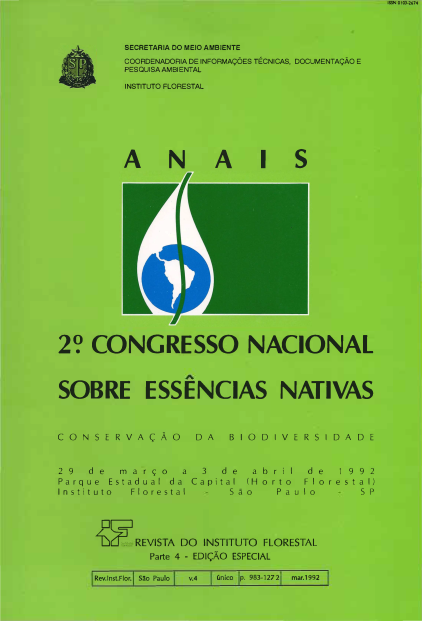OISTRIBÜIÇÃO GEOGRÁFICA DE SEIS ESPÉCIES FLORESTAIS COMO SUBsíDIO PARA A ESCOLHA DE ÁREAS FUTURAS DE CONSERVAÇÃO "IN SITU"
DOI:
https://doi.org/10.24278/2178-5031.199244775Abstract
The losses of plant genetic resources, in the tropics, are somehow related to anthropic action. The specialized literature recommend some strategies which allow to conserve the genetic diversity of target species. Among them,Astronium urundeuva, lIex paraguariensis, Ocotea pretiosa, Podocarpus lambertii, Schinopsis brasiliensis and Spondias tuberosa were chosen. This work intend to examine the geographic distribution of these species, as a first step of foregoing studies for the establishment of "in situ" conservation. Through surveys in herbarium and literature review, the data about species occurrence were obtained. The geographic coordinates of those locais were transfered to a geoprocessing software (Arcinfo) and plotted in a 1:10.000.000 scale map. Foreseeing new occurrences, each species was provided with a sphere of action of a 20 km ray around the incident spots. From this pararneter, the respective buffers were plotted, drawing limits for the areas to be studied.
Downloads
References
BURLEY, J. & NAMKOONG, G., 1980. Conservation of genetic resources. In: PAPER FOR 11 th COMMONWEALTH FORESTRY CO~FERENCE , Trinidad, 25 p.
EMBRAPA/CNPF, 1983. Seminário sobre atualidades e perspectivas florestais; silvicultura da erva-mate (lIex paraguariensis St. Hil.).ln: ANAIS DO X SEMINÁRIO SOBRE ATUALIDADES E PERSPECTIVAS FLORESTAIS, Curitiba, 146 p. (EMBRAPA/URPFCS. Documentos, 15).
FAO, 1982. Les ressourcesforestiêrestropicales. ÉTUDE FAO: FORÉTS - 30. Rome. 113 p.
FAO, 1983. Conservación y desarrollo de los recursos forestales tropicales. ESTUDIO FAO: MONTES - 37. Roma. 134 p.
FAO, 1986. Databook on endagered tree and shrub species and provenances. FAO FORESTRY PAPER - 77. Rome. 524 p.
FAO, 1989. Recursos fitogenéticos: su conservación "in situ" para el uso humano. Roma. 38 p.
FERNANDES, A. & BEZERRA, P., 1990. Estudos Fitogenéticos do Brasil. Fortaleza, Stylos Comunicações. 205 p.
FERNAN DES, A., 1990. Temas fitogeográficos. Stylos Comunicações. 116 p.
FRANKEL, O. H., 1971. Genetic conservatiorr in perspective. In: FRANKEL, o. H. & BENNETT, E. ed. Genetic Resources in Plants; their exploraton and conservetion. Oxford, Blackwell Scientific. p. 469- 489.
FRANKEL, O. H. & SOULÉ, M .E., 1981. Conserveiion and Evolution. Cambridge, University Press, Cambridqe. 327 p.
INSTITUTO BRASILEIRO DE GEOGRAFIA E ESTATíSTICA, 1971. índice dos Topônimos da Carta do Brasil ao Milionésimo. Rio de Janeiro. 322 p.
INSTITUTO BRASILEIRO DE GEOGRAFIA E ESTATíSTICA, 1972. Carta do Brasil ao Milionésimo. Rio de Janeiro. 46 p.
LEMÉE, G., 1967. Précis de Biogéographie. Paris, Masson & Cie. Éditeurs. 358 p.
MARTINS, P. S., 1986. Estrutura de populações e recursos genéticos. In: MESA REDONDA SOBRE CONSERVAÇÃO"IN SITU" DE RECURSOSGENÉ- TICOS FLORESTAIS. Piracicaba, Resumos. Piracicaba, ESALQ. 16 p.
ROCHE, L. & DOUROJEANNI, M.J., 1984.Aguideto"in situ" conservation of genetic resources of tropical woody species. Report Forgen/ MISC/84/2. Forestry departement. FAO. Rome. 196 p.
SAUVAGE, Ch., 1981. Étude des communautés végétales. In: COURS POST UNIVERSITAIRE MILlEU NATUREL - AMENAGEMENT. Montpellier, Université de Montpellier/CNRS/lNRA/Commission Française pour L'U.N.E.S.C.O. 200 p.
SPURR, S. H. & BARNES, B. V., 1976. Forest Ecology. New York, John Wiley & Sons. Third edition. 687 p.















